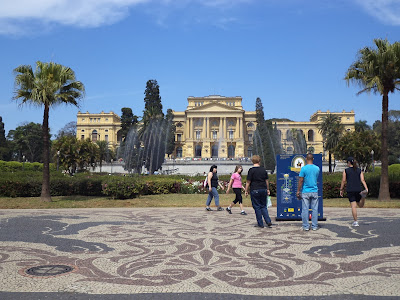"By the blood that flows in my veins and upon my honour, I swear to God to free Brazil" with this emotional phrase stated by Prince Pedro de Alcantara, in 1822, Brazil reached another step in its history and became independent from Portugal. The political context at the beginning of the nineteenth century contributed for the episode as other Latin American countries were facing revolutions and had the willing for independence as well.
Pedro desobeyed the demands of the Portuguese parliament and militar power that wished to keep Brazil as a colony. By refusing to come back to Portugal he looked for the support of the population and fellow freemasons group. On September 7th, coming back from a trip to the city of Santos he received a letter from his wife and his intellectual advisor, José Bonifácio de Andrada e Silva, telling him that the Portuguese government was sending troops to restore order. Pedro reacted immediately by tearing off the Portuguese insignia in his uniform and demanding his officials to do the same, breaking ties with Portugal. Three months after, Pedro de Alcântara was crowned the first emperor of Brazil.
Pedro desobeyed the demands of the Portuguese parliament and militar power that wished to keep Brazil as a colony. By refusing to come back to Portugal he looked for the support of the population and fellow freemasons group. On September 7th, coming back from a trip to the city of Santos he received a letter from his wife and his intellectual advisor, José Bonifácio de Andrada e Silva, telling him that the Portuguese government was sending troops to restore order. Pedro reacted immediately by tearing off the Portuguese insignia in his uniform and demanding his officials to do the same, breaking ties with Portugal. Three months after, Pedro de Alcântara was crowned the first emperor of Brazil.
It is exactly near the Ipiranga river, in the southeastern region of São Paulo city, that 100 years after the independence was settled, it was built the monument in honor to the independence. Times were different and the city of São Paulo got another political and economical status considering the wealthy generated by coffee production and the cultural influence of inumerous groups of immigrants that came from different European countries.
Monument in honor to the independence of Brazil, photo by Eliana Souza
Monument in honor to the Independence of Brazil, built in 1922,
photo by Eliana Souza
The monument was designed by Italian sculptor Ettore Ximenes who used methaphorical elements to tell the history of the independence. Carved in granite, panels and sculptures in bronze, the work of art has honored several figures involved in the process of independence during the centuries by treating them as national heroes.
Beneath there is a cripta which holds the mortal remains of Emperor Dom Pedro I and his wives, the Austrian Empress Maria Leopoldina and the French Empress Amélie de Leuchtenberg.
Monument in honor to the independence, Independence Park, photo by Eliana Souza
Surrounding the monument it is located one of the most important museums for people of São Paulo : the Paulista Museum, also known as Museum of Ipiranga. Both the monument and the museum are part of the Independence park, where locals come to relax, jogging and have fun with kids.
Independence park, pavement with Portuguese decorative stones,
photo by Eliana Souza
Paulista museum, at the Independence park, photo by Eliana Souza
The Italian engineer Tommaso Gaudenzio Bezzi, responsible by the project of the museum that took more than 5 years to be concluded at the end of the nineteenth century, employed several Italian craftsmen. The use of bricks revolutionized the technique of construction of other buildings and residences later in the city. The ecletic architectural style was based on Renaissance palaces.
The museum was used as a Natural History Museum for more than 20 years with a large collection of animals, plants and minerals. In 1917 under the supervision of Afonso de Taunay, it changed its directions to be transformed in a relevant historical museum. Taunay commisioned several paintings and works of art aiming at drawing a visual panel to point out the presence of paulistas (people born in São Paulo) as protagonists in several important episodes of the development of the Brazil. A whole floor was devoted to the independence that took place in São Paulo, near to the region where the museum was settled. More than 100.000 items compose the collection that includes furniture, clothing and archelogical objects related to the history of the city since it has been a tiny village up to the transformation in a real cosmopolitan urban center.
Paulista Museum and gardens, photo by Eliana Souza
To beautify the surroundings, topiaries, roses, water fountains and arabesques are part of the gardens in front of the museum. Designed by Belgian landscape artist Arsenius Puttemans, they were based on Versailles Gardens in France and give the whole complex a trendy European atmosphere.
Independence park, fountains, photo by Eliana Souza
Independence park, fountains, photo by Eliana Souza

Independence park, fountains, photo by Eliana Souza

Independence park, side walk, photo by Eliana Souza
Unfortunately the museum is closed nowadays for renovation.
Paulista Museum - Museu Paulista
Parque da Independencia, s/nº - Ipiranga
www.mp.usp.br
phone: + 55 11 2065-8000
Eliana Souza - SPin Brazil Tours






.JPG)










